I’d cycled down from the mid-elevation mountains that separate Nantou County from Taichung City, then found yet more hills lay between me and the train station where I planned to leave my bike. By the time I reached Taian (泰安), it had been dark for more than an hour. Sightseeing would have to wait until I returned.
Taian TRA Station isn’t in Miaoli County’s Taian Township (泰安鄉), but rather in Houli District (后里區) in Taichung City. It’s less than 500m from the southbank of the Daan River (大安溪), the other side of which belongs to Miaoli County’s Sanyi Township (三義鄉).
When I returned by local train a few days later, the weather was perfect. From the station’s platform, which is elevated well above the plain, I enjoyed excellent views over the surrounding countryside. Looking upriver, I could see the Daan River Iron Bridge (大安溪鐵橋), part of what’s known as the Old Mountain Line (舊山線).
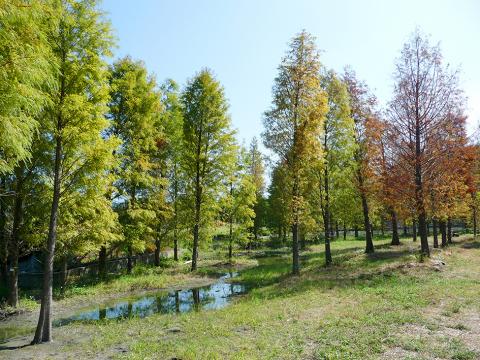
Photo: Steven Crook
Between 1908 and 1998, this bridge carried passenger and freight trains across the Daan River. When the authorities inaugurated a straighter alternative rail route between Houli TRA Station and Sanyi TRA Station, a 15.9-km-long stretch of tracks was retired, as were eight tunnels, three bridges, and two station buildings.
The more famous of the two old stops is Shengsing Station (勝興火車站). At an altitude of 402 meters above sea level, it used to be the highest point on Taiwan’s conventional railway network. Every weekend, Shengsing Station draws crowds of tourists.
Far fewer people go to Taian Railway Cultural Park (泰安鐵道文化園區), which preserves the old Taian station. I broke the short ride between the new and old stations by stopping at a couple of local attractions just off Anmei Road (安眉路).
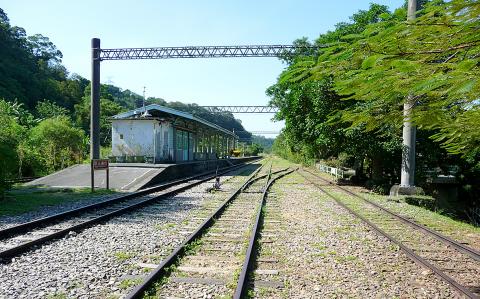
Photo: Steven Crook
The first was Taian Lovers Tree (泰安情人樹), on the grounds of Taian Elementary School (泰安國民小學). It’s actually a pair of banyan trees. In combination, they create an impressive patch of shade — but I think another tree nearby is more photogenic.
Beside the unnumbered lane that leads to Taian’s much-Instagrammed plantation of bald cypresses, a big tree stands behind a shrine to the local land god. At the time of my visit, it was leafless and perhaps lifeless, yet still wrapped with a red ribbon to symbolize its holy status. The lack of obvious health caused me to wonder: In local popular religion, what happens when a sacred tree dies?
The Secret World of Taian’s Bald Cypresses (泰安落羽松祕境) is smaller than a soccer pitch, and it isn’t the only place in Taiwan where you can see Taxodium distichum, a deciduous conifer species that’s native to the southeastern parts of the US. But on the day I visited, the orange, red and yellow leaves, together with the blue autumn sky, made for a lovely sight.
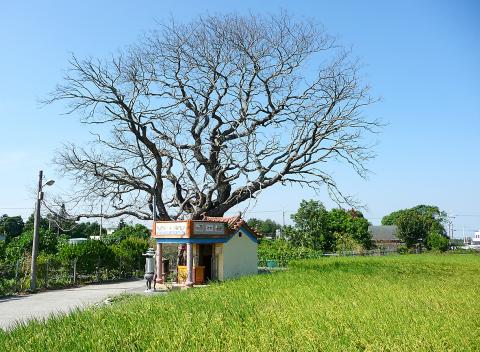
Photo: Steven Crook
The main station building at Taian Railway Cultural Park is concrete, and while it lacks the allure of the picturesque Japanese colonial-era wooden structure at Shengsing, it has a certain appeal. The entrance is above street level but lower than the actual tracks. These remain in place, and it’s possible to walk northeast along them for about 700m to Daan River Iron Bridge. The old platform looks like an ideal spot for a picnic.
Between the tracks and the hillside, shaped like an artillery shell pointing at the sky, the Earthquake Rehabilitation Monument (震災復興紀念碑) commemorates both the April 21, 1935 tremor (the deadliest earthquake in Taiwan’s recent history, killing 3,422 people) and the reconstruction efforts which followed it. The quake wrecked Longteng Broken Bridge (龍騰斷橋, also known as Yutengping Broken Bridge, 魚藤坪斷橋), which is 4.8km north as the crow flies and now a tourist attraction almost as popular as Shengsing Station.
I rode to the southern end of Daan River Iron Bridge, and was disappointed but not surprised to find it fenced off. The 637-meter-long bridge, which took five years to complete and was declared a municipal-level relic in 2017, looks structurally sound. At some point in the future, hopefully, the authorities will repurpose it for pedestrians and/or cyclists.
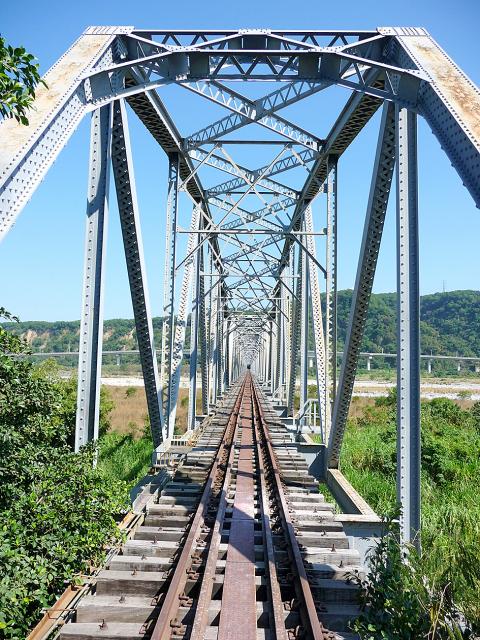
Photo: Steven Crook
Before striking out for Taichung’s coastline, about 18km west of Taian TRA Station, I had one more goal. I wanted to snap a few pictures of the badly eroded hills on the other side of the river. Huoyan Mountain (火炎山) is a much-photographed patch of bare ridges that becomes especially eye-catching around sunset. When I came across a multi-story temple just west of Freeway 1, I dashed up the stairs and started shooting. I then spent a minute or two taking in 360-degree views. There was no direction which didn’t tempt me: Too many roads, not enough time!
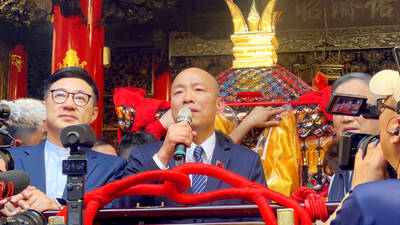
Three big changes have transformed the landscape of Taiwan’s local patronage factions: Increasing Democratic Progressive Party (DPP) involvement, rising new factions and the Chinese Nationalist Party’s (KMT) significantly weakened control. GREEN FACTIONS It is said that “south of the Zhuoshui River (濁水溪), there is no blue-green divide,” meaning that from Yunlin County south there is no difference between KMT and DPP politicians. This is not always true, but there is more than a grain of truth to it. Traditionally, DPP factions are viewed as national entities, with their primary function to secure plum positions in the party and government. This is not unusual
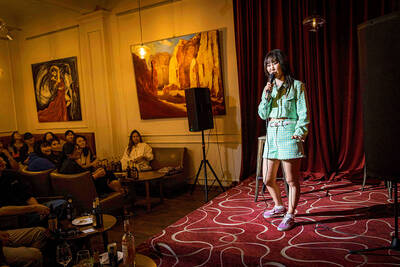
Mongolian influencer Anudari Daarya looks effortlessly glamorous and carefree in her social media posts — but the classically trained pianist’s road to acceptance as a transgender artist has been anything but easy. She is one of a growing number of Mongolian LGBTQ youth challenging stereotypes and fighting for acceptance through media representation in the socially conservative country. LGBTQ Mongolians often hide their identities from their employers and colleagues for fear of discrimination, with a survey by the non-profit LGBT Centre Mongolia showing that only 20 percent of people felt comfortable coming out at work. Daarya, 25, said she has faced discrimination since she

April 21 to April 27 Hsieh Er’s (謝娥) political fortunes were rising fast after she got out of jail and joined the Chinese Nationalist Party (KMT) in December 1945. Not only did she hold key positions in various committees, she was elected the only woman on the Taipei City Council and headed to Nanjing in 1946 as the sole Taiwanese female representative to the National Constituent Assembly. With the support of first lady Soong May-ling (宋美齡), she started the Taipei Women’s Association and Taiwan Provincial Women’s Association, where she
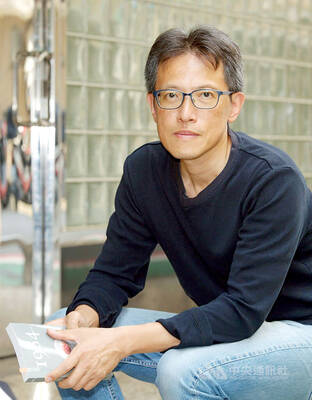
More than 75 years after the publication of Nineteen Eighty-Four, the Orwellian phrase “Big Brother is watching you” has become so familiar to most of the Taiwanese public that even those who haven’t read the novel recognize it. That phrase has now been given a new look by amateur translator Tsiu Ing-sing (周盈成), who recently completed the first full Taiwanese translation of George Orwell’s dystopian classic. Tsiu — who completed the nearly 160,000-word project in his spare time over four years — said his goal was to “prove it possible” that foreign literature could be rendered in Taiwanese. The translation is part of